Have you ever struggled with losing weight and keeping it off? Perhaps you’ve tried numerous diets and exercise plans, but nothing seems to work long-term. If that’s the case, have you considered the role that fiber plays in weight loss? Fiber is an essential nutrient that offers numerous benefits for your health, including a reduced risk of obesity. But what exactly is fiber, and how does it work in the body? In this article, we’ll explore the link between high-fiber intake and reduced obesity risk, as well as provide tips on how to incorporate more high-fiber foods into your diet.
What is Fiber and How Does it Work in Your Body?
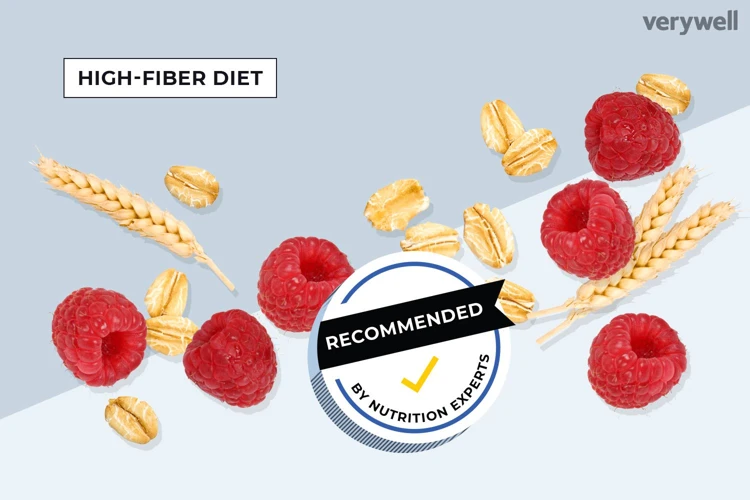
Fiber is a type of carbohydrate that your body can’t digest. Instead of providing your body with energy like other carbohydrates, fiber moves through your digestive system mostly intact. There are two types of fiber: soluble and insoluble.
Soluble fiber dissolves in water and forms a gel-like substance that helps slow down digestion. This type of fiber can help stabilize your blood sugar levels and lower cholesterol levels. Soluble fiber is found in foods such as beans, oats, apples, and berries.
Insoluble fiber, on the other hand, doesn’t dissolve in water and adds bulk to your stool. This type of fiber promotes bowel regularity and can help prevent constipation. Insoluble fiber is found in foods such as whole grains, nuts, and vegetables.
Fiber is essential for maintaining a healthy digestive system. When you eat foods that contain fiber, the fiber works by absorbing water in your digestive tract, which helps to soften your stool and make it easier to pass. A high-fiber diet can help prevent digestive problems such as constipation, hemorrhoids, and diverticulitis.
Fiber can also help regulate your appetite and aid in weight loss. When you eat a high-fiber meal, it takes longer for your body to digest. As a result, you stay fuller for longer periods of time and are less likely to overeat. Additionally, high-fiber foods tend to be lower in calories, which can help reduce your overall calorie intake.
Fiber is an important component of a healthy diet that supports weight loss and digestive health. By incorporating both soluble and insoluble fiber into your daily diet, you can optimize your health and reduce your risk of obesity and other health problems.
The Difference Between Soluble and Insoluble Fiber
Fiber is an essential component of a healthy diet, but not all fiber is created equal. There are two main types of fiber – soluble and insoluble, each with unique qualities that impact the body differently. While the thought of different types of fiber may seem confusing, understanding the difference between the two can help you make more informed choices about which high-fiber foods to include in your diet. So, let’s explore the different types of fiber and their impact on the body.
How Fiber Affects Your Digestive System
Fiber plays an important role in maintaining digestive health. When fiber is consumed, it passes through the stomach and small intestine relatively unchanged. However, once it reaches the large intestine, it begins to work its magic.
Here are some ways fiber affects your digestive system:
- Constipation Relief: Soluble fiber absorbs water and creates a gel-like substance which helps soften stool and make it easier to pass. Insoluble fiber adds bulk to stools and helps them move through the intestines more quickly.
- Prevention of Diverticular Disease: Diverticular disease occurs when small pouches form in the wall of the colon and become inflamed or infected. A diet high in fiber can prevent this condition by keeping the colon healthy and preventing constipation which can lead to inflammation and infection.
- Lower Risk of Colon Cancer: The fermentation of fiber in the colon produces short-chain fatty acids which can help protect against colon cancer by reducing inflammation and promoting the growth of healthy gut bacteria.
- Improved Gut Health: Gut bacteria thrive on fiber, particularly soluble fiber. This helps maintain a healthy balance of gut bacteria, which is important for overall digestive health and immune function.
It’s important to note that too much fiber too quickly can cause digestive discomfort such as bloating and gas. It’s recommended to gradually increase fiber intake and drink plenty of water to avoid these uncomfortable side effects.
How High-Fiber Foods Can Help You Lose Weight
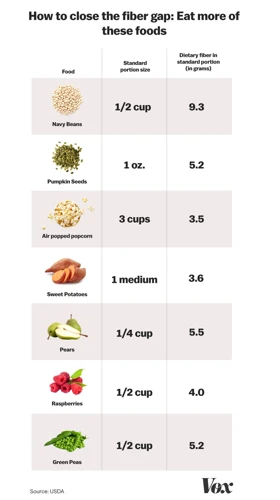
Fiber plays an essential role in weight management, and adding high-fiber foods to your diet can help you achieve your weight loss goals. There are several ways in which high-fiber foods can help you lose weight, including keeping you feeling full, stabilizing blood sugar levels, and reducing the number of calories you consume.
High-Fiber Foods Keep You Feeling Full: One of the main reasons fiber is beneficial for weight loss is that it helps you feel full for longer periods. High-fiber foods tend to be more filling than those that are low in fiber because they take longer to digest. When you eat foods that are high in fiber, you have a sense of being full, which can help you eat less throughout the day. This can lead to a reduction in the number of calories you consume, which in turn can lead to weight loss.
Fiber Helps Stabilize Blood Sugar Levels: Another benefit of high-fiber foods is that they help to keep blood sugar levels stable. When you eat foods that are high in fiber, they take longer to digest, which means that they release glucose into your bloodstream more slowly. This slows down the rate at which glucose is absorbed, which can help to prevent insulin spikes. When your blood sugar levels are stable, you are less likely to experience cravings for sugary or high-calorie foods, which can help you lose weight.
Fiber Leads to Fewer Calories Consumed: In addition to keeping you feeling full and stabilizing blood sugar levels, high-fiber foods can also help you consume fewer calories. Because high-fiber foods tend to be more filling, you are less likely to snack or reach for high-calorie foods throughout the day. This can lead to an overall reduction in your calorie intake, which can help you lose weight.
Incorporating high-fiber foods into your diet can be an effective way to support your weight loss efforts. High-fiber foods can help you feel full, stabilize blood sugar levels, and reduce the number of calories you consume, making it easier to achieve and maintain a healthy weight.
High-Fiber Foods Keep You Feeling Full
Are you tired of constantly feeling hungry while trying to lose weight? One solution could be incorporating more high-fiber foods into your diet. These foods not only provide essential nutrients for your body, but they can also help you feel fuller for longer periods of time. In this section, we’ll explore how fiber works to keep you feeling satisfied and why it’s an important component in any weight loss plan.
Fiber Helps Stabilize Blood Sugar Levels
One of the key benefits of fiber-rich foods is their ability to help stabilize blood sugar levels. This is particularly important for people who are at risk of or who have type 2 diabetes. Here are some ways that fiber can help:
- Fiber slows down the absorption of glucose into the bloodstream: When you eat high-carbohydrate foods, your body breaks them down into glucose, which then enters the bloodstream. However, consuming fiber at the same time can help slow down that process. This is because fiber slows down the rate at which food moves through your digestive system, which means that glucose is absorbed more slowly. As a result, blood sugar levels don’t spike as quickly and insulin is released in a more controlled manner.
- Fiber promotes insulin sensitivity: Insulin is a hormone that helps your body use glucose for energy. However, in people who are insulin resistant (such as those with type 2 diabetes), the body doesn’t respond to insulin as effectively as it should. This means that glucose stays in the bloodstream for longer, potentially leading to high blood sugar levels. However, research has shown that a diet high in fiber can help promote insulin sensitivity in these individuals, which means that their body can use insulin more effectively.
- Fiber helps the body process carbohydrates: When you eat foods that contain carbohydrates, your body breaks them down into glucose. However, some types of carbohydrates are broken down more quickly than others. For example, refined carbohydrates (such as those found in white bread and pasta) are broken down very quickly, leading to a rapid rise in blood sugar levels. On the other hand, complex carbohydrates (such as those found in whole grains and vegetables) are broken down more slowly. Fiber can help slow down the absorption of both types of carbohydrates, which helps to prevent blood sugar spikes.
All of these factors contribute to fiber’s ability to help stabilize blood sugar levels, which in turn can help reduce the risk of type 2 diabetes and other health problems associated with high blood sugar.
Fiber Leads to Fewer Calories Consumed
Studies have shown that fiber-rich foods can lead to a reduction in calorie intake. This is partly due to the fact that high-fiber foods, such as fruits, vegetables, and whole grains, are often low in calories and can be quite filling. Fiber can help slow down the digestive process, which can increase feelings of fullness and reduce the likelihood of overeating.
A study published in the American Journal of Clinical Nutrition found that adding fiber to meals resulted in a significant decrease in calorie intake. The study found that participants who ate oatmeal with added fiber consumed fewer calories during their next meal compared to those who ate a low-fiber oatmeal. Another study published in the Journal of the Academy of Nutrition and Dietetics found that increasing fiber intake by just 6 grams per day led to a reduction in calorie intake by up to 10%.
Eating high-fiber foods may also reduce the temptation to snack on high-calorie, low-nutrient foods. Fiber-rich foods take longer to eat and digest, which can lead to a decrease in overall food consumption throughout the day.
Here is a table summarizing some high-fiber foods and their approximate calorie contents:
| Food | Fiber Content (grams) | Calories per Serving |
|---|---|---|
| 1 medium apple with skin | 4.4 | 95 |
| 1 cup raspberries | 8 | 64 |
| 1 cup cooked lentils | 15.6 | 230 |
| 1 slice whole wheat bread | 2 | 79 |
| 1 cup cooked quinoa | 5.2 | 222 |
As you can see, these high-fiber foods have relatively low calorie counts compared to other foods, making them a great choice for those looking to reduce calorie intake and lose weight.
Research on The Benefits of High-Fiber Intake in Reducing Obesity Risk
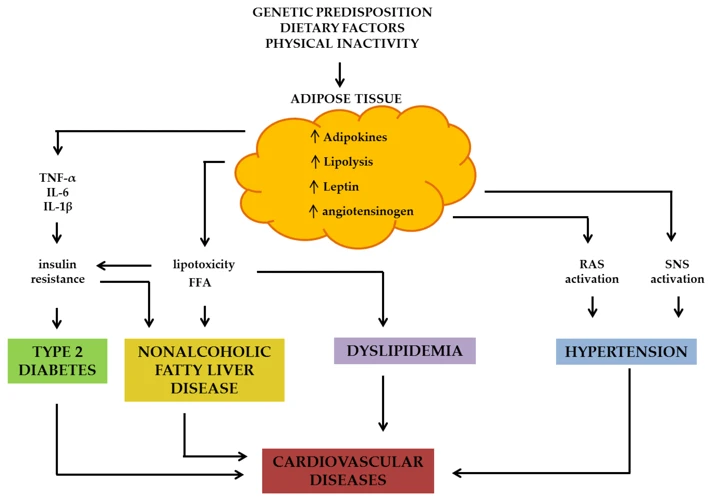
Studies have shown that a high-fiber diet can be beneficial in reducing the risk of obesity. One study published in the Annals of Internal Medicine followed 240 participants over a 12-month period and found that those who were instructed to eat a high-fiber diet lost significantly more weight than those who were instructed to follow a lower-fiber diet.
Another analysis of 21 different studies found that consuming at least 30 grams of fiber daily led to significant weight loss compared to those who consumed less fiber. The study also found that the type of fiber consumed – either soluble or insoluble – did not make a difference in the weight loss results.
Research has found that consuming a high-fiber diet can help reduce belly fat. A study published in the journal Obesity followed 1,114 participants over five years and found that those who increased their fiber intake had less visceral fat (fat stored in the abdominal cavity) than those who decreased their fiber intake.
While the exact mechanisms behind the link between high-fiber intake and reduced obesity risk are not fully understood, some research has suggested that fiber may help regulate appetite hormones and improve insulin sensitivity. However, more research is needed to fully understand the effects of fiber on the body.
The research indicates that a diet high in fiber can be an effective way to reduce the risk of obesity and promote weight loss. By incorporating more high-fiber foods into your diet, you may be able to achieve a healthier body weight and lower your risk of developing obesity-related health issues.
Studies Link Higher Fiber Intake To Lower Body Weight
For those struggling with obesity, the idea of losing weight can seem like an insurmountable task. However, recent studies have shown a potential link between increased fiber intake and reducing the risk of obesity. This finding is a ray of hope for those seeking effective and healthy weight loss solutions. In this section, we will explore the research behind this link and how it could potentially benefit individuals on their weight loss journey.
How Fiber Can Help Shed Belly Fat
Research shows that fiber can help reduce belly fat and decrease overall body weight. Belly fat, also known as visceral fat, surrounds the organs in the abdominal area and is linked to an increased risk of heart disease, diabetes, and other health problems. However, incorporating high-fiber foods into your diet can help combat belly fat and improve overall health.
Fiber-rich foods are typically low in calories and take longer to digest, which means they keep you feeling full for longer periods of time. This can help you consume fewer calories overall, thereby aiding in weight loss. Soluble fiber, in particular, has been shown to reduce belly fat accumulation by promoting the release of hormones that control appetite and fat storage.
Food high in fiber can also help regulate blood sugar levels. When blood sugar levels are stable, the body is able to burn stored fat for energy. However, when blood sugar levels are constantly spiking and crashing, it can lead to increased fat storage and difficulty losing weight. By eating foods high in fiber, like beans and whole grains, you can help keep your blood sugar levels stable and promote fat burning.
To understand how fiber can reduce belly fat, let’s take a closer look at the mechanisms involved. One study found that soluble fiber helped decrease the amount of belly fat in obese individuals. The researchers speculated that this was due to the production of short-chain fatty acids (SCFAs) by gut bacteria. These SCFAs were found to stimulate the release of hormones that reduce appetite and increase fat burning.
Another study supported this theory, finding that increasing fiber intake led to a greater decrease in belly fat than simply reducing calorie intake alone. Participants who consumed an extra 14 grams of fiber per day for four months were able to significantly reduce belly fat and overall body weight compared to those who did not increase their fiber intake.
Research suggests that incorporating high-fiber foods into your diet is a valuable strategy for reducing belly fat and achieving a healthy weight. To get the most benefit, aim for at least 25-30 grams of fiber per day and focus on incorporating a variety of high-quality sources into your diet.
How Much Fiber You Need Daily
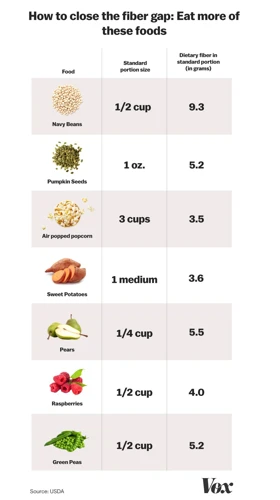
Getting enough fiber in your diet is important for maintaining a healthy weight and reducing your risk of chronic diseases. But how much fiber should you aim to consume each day? According to the American Heart Association, the recommended daily fiber intake is 25 grams for women and 38 grams for men. However, most people fall short of this goal, with the average American consuming only about half of that amount each day.
To meet your daily fiber needs, it’s important to include plenty of high-fiber foods in your diet. Some good sources of fiber include fruits, vegetables, whole grains, nuts, and seeds. It’s also important to include both soluble and insoluble fiber in your diet, as each type offers different health benefits.
If you’re not used to eating a lot of fiber, it’s important to gradually increase your intake over time. Increasing your fiber intake too quickly can lead to digestive discomfort, such as bloating and gas. Additionally, it’s important to stay well-hydrated when consuming more fiber, as fiber absorbs water and can lead to constipation if you’re not drinking enough.
Experimenting with new high-fiber foods can also help you increase your fiber intake. Incorporating different fruits, vegetables, and whole grains into your meals can help you get the fiber you need while also adding variety to your diet. Additionally, opting for fiber-rich snacks such as nuts, seeds, or fresh fruit can help boost your daily fiber intake.
Remember, including enough fiber in your diet is an important component of a healthy lifestyle. By aiming to meet the recommended daily fiber intake, you can improve your overall health and reduce your risk of chronic diseases such as obesity, heart disease, and diabetes.
Recommended Daily Fiber Intake
Have you ever wondered how much fiber you should be consuming on a daily basis? The answer may surprise you. The American Heart Association recommends a daily fiber intake of 25 to 30 grams for adults, but the average person only consumes about half of that amount. This lack of fiber in our diets can contribute to a variety of health issues, including constipation, heart disease, and yes, even obesity. But don’t worry – it’s easy to incorporate more fiber into your diet with just a few simple changes. Keep reading to find out how.
Easy Ways to Increase Your Fiber Intake
Adding more fiber to your diet can be easier than you think! Here are some simple ways you can increase your fiber intake:
- Choose whole grains: When you’re shopping for bread, pasta, rice, and other grain-based foods, look for products that are made from whole grains. These foods contain more fiber than their refined counterparts, which have had the fiber-rich outer layer stripped away.
- Snack on fruits and vegetables: Fresh or frozen fruits and vegetables are an excellent source of fiber. Try to include at least one serving of fruits or vegetables with every meal and snack.
- Go nuts: Nuts and seeds are not only a good source of fiber, but they’re also high in healthy fats and protein. Add a handful of almonds, walnuts, or sunflower seeds to your diet for a nutrient boost.
- Eat legumes: Beans, lentils, and chickpeas are all fantastic sources of fiber. Try adding them to soups, stews, salads, or even blending them into dips like hummus.
- Swap in a fiber supplement: If you’re having trouble getting enough fiber from your diet, you can try taking a fiber supplement. However, it’s always best to get your fiber from whole foods whenever possible.
By incorporating these easy ways to increase your fiber intake, you’ll be well on your way to a healthier diet and reducing your risk of obesity. Remember, it’s important to gradually increase your fiber intake and drink plenty of water to help your body adjust.
What High-Fiber Foods You Should Be Eating
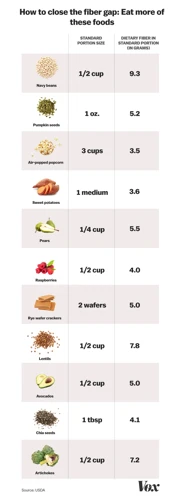
Getting enough fiber can be challenging, but it doesn’t have to be. There are many high-fiber foods that you can easily incorporate into your diet. Some of the top sources of soluble fiber include oats, oat bran, barley, lentils, peas, beans, apples, citrus fruits, berries, and psyllium husk. These foods form a gel in the digestive tract, which helps to slow down digestion and keep you feeling full for longer periods of time.
If you’re looking to increase your intake of insoluble fiber, which helps regulate bowel movements and prevent constipation, try incorporating foods such as whole wheat, whole grains, wheat bran, nuts, seeds, avocado, and vegetables like broccoli, cauliflower, and leafy greens into your diet.
It’s important to note that most high-fiber foods contain both soluble and insoluble fiber, so consuming a variety of these foods can help you get the benefits of both types of fiber.
When choosing high-fiber foods, it’s also important to pay attention to the sugar and calorie content. Some high-fiber foods, such as sugary granola bars or processed cereals, can be high in added sugars and calories. Instead, opt for whole food sources of fiber and incorporate them into your meals and snacks throughout the day.
Getting enough fiber can feel daunting at first, but with a little effort and planning, it can become a regular part of your healthy eating habits. Aim to include a variety of high-fiber foods into your meals and snacks each day for optimal health benefits.
Top Sources of Soluble Fiber
Many people are aware that fiber is essential for maintaining a healthy diet, but not everyone knows that there are different types of fiber. Soluble fiber is a type of fiber that dissolves in water, creating a gel-like substance that helps slow down digestion. This type of fiber offers many benefits, including helping to reduce cholesterol levels and keeping blood sugar levels stable. It can be found in a variety of plant-based foods. In this section, we will explore some top sources of soluble fiber and how you can incorporate them into your daily diet.
Top Sources of Insoluble Fiber
Insoluble fiber can help promote a healthy digestive system by adding bulk to stool and preventing constipation. Here are some of the top sources of insoluble fiber:
- Wheat bran: Wheat bran is the outer layer of the wheat kernel and is a great source of insoluble fiber. You can add it to baked goods, oatmeal, or smoothies to increase your fiber intake.
- Whole grains: Whole grains like brown rice, barley, and quinoa are rich in insoluble fiber. They make a great base for salads or can be served as a side dish.
- Nuts and seeds: Nuts and seeds like almonds, sunflower seeds, and pumpkin seeds are not only high in healthy fats and protein, but also contain insoluble fiber. Sprinkle them on top of salads or oatmeal for an extra boost of fiber.
- Vegetables: Vegetables like carrots, broccoli, and Brussels sprouts are great sources of insoluble fiber. Roast or steam them as a side dish or add them to soups and stews.
- Fruit: While most fruits are high in soluble fiber, some also contain insoluble fiber. Apples, pears, and berries are a few examples. Eat them as a healthy snack or add them to oatmeal or yogurt for a fiber-rich breakfast.
It’s important to remember that a variety of high-fiber foods is key to a healthy diet. Incorporating a combination of both soluble and insoluble fiber can help promote digestive health and aid in weight loss.
Tips for Adding More High-Fiber Foods to Your Diet
Adding more high-fiber foods to your diet can seem like a daunting task, but it doesn’t have to be. Here are some easy tips to help you increase your fiber intake:
Gradually Increase Your Fiber Intake and Drink More Water: Suddenly increasing your fiber intake can cause digestive discomfort such as bloating and abdominal pain. It’s best to gradually increase your fiber intake over a few weeks to give your body time to adjust. Drinking plenty of water is also important when increasing fiber intake as it helps move fiber through the digestive system.
Eat a Varied Diet and Experiment with New Foods: Eating a variety of high-fiber foods is important to ensure you get a range of nutrients in your diet. Experimenting with new high-fiber foods can also keep your meals interesting and prevent boredom. Try incorporating foods like lentils, chickpeas, chia seeds, quinoa, and barley into your diet.
Choose Whole Grains: When looking for high-fiber grains, make sure to choose whole grains over refined grains. Whole grains retain the bran and germ of the grain, which contains most of the fiber and nutrients. Good examples of whole grains include brown rice, whole wheat bread, and oatmeal.
Add More Fruits and Vegetables: Fruits and vegetables are excellent sources of fiber and other important nutrients. Aim to fill half your plate with fruits and vegetables at each meal. This can include fresh or frozen options, and can be eaten as a snack or incorporated into meals.
Choose High-Fiber Snacks: Snacks can be a great way to add more fiber to your diet, but it’s important to choose high-fiber options. Some good examples include popcorn, fresh fruit or vegetables with a hummus dip, or a small handful of nuts or seeds.
Incorporating more high-fiber foods into your diet doesn’t have to be difficult. By following these simple tips, you can increase your fiber intake and reap the many health benefits associated with a high-fiber diet.
Gradually Increase Your Fiber Intake and Drink More Water
As with any dietary change, it’s important to start slowly when increasing your fiber intake. Incorporating too much fiber too quickly can lead to digestive discomfort such as bloating, gas, and even constipation. That’s why it’s important to gradually increase your fiber intake while also drinking plenty of water to help ease the transition. In this section, we’ll cover some tips on how to safely and effectively increase your daily fiber intake.
Eat a Varied Diet and Experiment with New Foods
One of the keys to incorporating more high-fiber foods into your diet is to eat a varied diet and experiment with new foods. Variety is important because no single food contains all the nutrients your body needs, and consuming a wide range of foods ensures you get a diverse array of nutrients. Try to include a mix of fruits, vegetables, legumes, whole grains, nuts, and seeds in your meals and snacks.
To experiment with new foods, try different varieties of whole grains like quinoa, farro, or barley. Mix things up with new vegetables like jicama, kale, or bok choy. Don’t be afraid to try new recipes or spice combinations to keep things interesting and flavorful.
Another way to incorporate new high-fiber foods into your diet is to try ethnic foods. For example, try adding chickpeas to your salads or hummus as a dip for vegetables or crackers. Alternatively, try adding lentils to soups, stews, or Indian-inspired dishes like dal.
Finally, when shopping, try to choose whole foods instead of processed foods, which are often low in fiber and high in added sugars and unhealthy fats. Look for fresh produce, whole grains, and beans in the bulk section of your grocery store. Also, be sure to read labels and choose products that are high in fiber, such as breads made with whole grains or high-fiber cereals. By incorporating a variety of high-fiber foods into your diet, you can not only reduce your risk of obesity but also improve your overall health and well-being.
The Bottom Line: Include High-Fiber Foods in Your Weight Loss Plan
To summarize, it is clear that high-fiber foods can be incredibly beneficial for weight loss and reducing obesity risk. While there are many factors that contribute to weight, research shows that a diet high in fiber can play a significant role in shedding those extra pounds.
So if you’re looking to lose weight, it’s important to make sure you’re incorporating plenty of high-fiber foods into your diet. These foods will not only help you feel fuller for longer, but they can also help you consume fewer calories in the long run.
Remember to aim for at least 25-30 grams of fiber per day, and focus on getting a variety of both soluble and insoluble fiber. Some of the top sources of fiber include fruits, vegetables, whole grains, nuts, and seeds.
But increasing your fiber intake too quickly can sometimes lead to digestive discomfort, so it’s important to make changes gradually and drink plenty of water throughout the day. Additionally, incorporating new high-fiber foods into your diet can help keep things interesting and prevent boredom.
Including high-fiber foods in your weight loss plan can be a simple yet effective way to support your weight loss goals and improve your overall health. So don’t hesitate to start experimenting with new fiber-rich foods and see what works best for you.
Frequently Asked Questions
What is the recommended daily fiber intake?
The recommended daily fiber intake for adults is 25-30 grams.
What are the top sources of soluble fiber?
The top sources of soluble fiber include oats, beans, peas, apples, carrots, and flaxseeds.
What are the top sources of insoluble fiber?
The top sources of insoluble fiber include wheat bran, whole-grain bread, brown rice, seeds, and nuts.
How does fiber help stabilize blood sugar levels?
Fiber helps slow down the rate at which the body absorbs glucose, which helps prevent spikes in blood sugar levels.
Can high-fiber foods help reduce belly fat?
Yes, studies have shown that high-fiber diets can help reduce belly fat.
What are some easy ways to increase fiber intake?
Some easy ways to increase fiber intake include incorporating more fruits, vegetables, beans, and whole grains into your diet and snacking on nuts and seeds.
How does fiber help with weight loss?
Fiber helps with weight loss by keeping you feeling full, stabilizing blood sugar levels, and leading to fewer calories consumed.
What is the difference between soluble and insoluble fiber?
Soluble fiber dissolves in water and forms a gel-like substance in the digestive tract, while insoluble fiber does not dissolve in water and adds bulk to stool.
How does fiber affect digestion?
Fiber helps promote regular bowel movements and can prevent constipation by adding bulk to stool.
Why is it important to gradually increase fiber intake and drink more water?
It’s important to gradually increase fiber intake and drink more water to prevent digestive discomfort and help fiber move through the digestive tract more easily.







